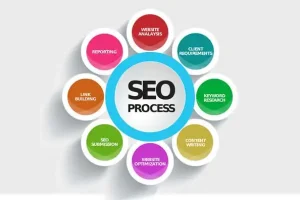
Search Engine Optimization Success Guide 2024
2024 Search Engine Optimization (SEO) Success Guide: Tools & Tactics To Refresh Your Strategy & Boost Performance
Introduction:
In the ever-changing landscape of online marketing, staying ahead is very important for online success. As we step into 2024, the importance of a robust Search Engine Optimization strategy cannot be overstated. Search Engine Optimization (SEO) continues to be a cornerstone for driving organic traffic and ensuring visibility on search engine results pages (SERPs). In this comprehensive guide, we’ll explore the latest tools and tactics to refresh your SEO strategy and boost performance in 2024.
Section 1: Understanding the SEO Landscape in 2024
1.1 The Evolution of Search Algorithms:
Google’s search algorithms are constantly evolving, and understanding their updates is key to SEO success. Stay informed about the latest algorithm changes, such as Core Web Vitals, page experience signals, and mobile-first indexing.
1.2 User Intent Optimization:
2024 places a strong emphasis on understanding user intent. Tailor your content to match the searcher’s intent, focusing on providing valuable information and addressing user needs effectively.
Section 2: Essential SEO Tools for 2024
2.1 Google Search Console:
An indispensable tool, Google Search Console provides valuable insights into your website’s performance on Google Search. Monitor your site’s indexing status, search queries, and fix issues that may hinder visibility.
2.2 SEMrush:
SEMrush is a comprehensive SEO toolkit offering features like keyword research, backlink analysis, and competitor tracking. Leverage its capabilities to identify high-performing keywords and stay ahead of your competitors.
2.3 Ahrefs:
Ahrefs is a powerhouse for backlink analysis, keyword research, and site audits. Utilize its features to discover new link-building opportunities, conduct competitor analysis, and enhance your site’s overall health.
2.4 Moz:
Moz is renowned for its SEO tools, including Moz Pro and Moz Local. It provides valuable insights into your website’s domain authority, on-page optimization, and local SEO performance.
Section 3: Tactical SEO Strategies for 2024
3.1 Mobile Optimization:
With the increasing use of mobile devices, ensuring your website is mobile-friendly is non-negotiable. Prioritize mobile optimization, responsive design, and fast loading times to enhance user experience and satisfy search engine requirements.
3.2 Content Quality and Relevance:
Craft high-quality, relevant content that aligns with user intent. Long-form, informative content tends to perform well, and integrating multimedia elements like images and videos can further enhance engagement.
3.3 Voice Search Optimization:
Voice search is gaining prominence, and optimizing your content for voice queries is essential. Focus on natural language, conversational content, and provide concise answers to commonly asked questions.
3.4 Video SEO:
Video content continues to dominate online platforms. Optimize your videos with descriptive titles, transcripts, and relevant keywords. Utilize video sitemaps to help search engines index your video content effectively.
3.5 Local SEO:
For businesses targeting a local audience, optimizing for local search is paramount. Claim and optimize your Google My Business listing, encourage customer reviews, and ensure accurate NAP (Name, Address, Phone) information across online platforms.
Section 4: Technical SEO Best Practices
4.1 Site Speed Optimization:
Page loading speed is a critical factor influencing both user experience and search engine rankings. Regularly audit your website’s speed using tools like Google PageSpeed Insights and work on optimizations, such as image compression, browser caching, and minimizing HTTP requests.
4.2 Schema Markup Implementation:
Enhance the visibility of your content in search results by implementing schema markup. Schema markup provides additional context to search engines, enabling them to better understand the content on your pages. This can result in rich snippets and increased click-through rates.
4.3 SSL Encryption:
Secure your website with SSL encryption. Google prioritizes secure sites, and having HTTPS in your URL not only boosts your search rankings but also instills trust among users. Ensure all pages on your site are served over HTTPS for a secure browsing experience.
Section 5: Analytics and Monitoring
5.1 Google Analytics:
Regularly monitor your website’s performance using Google Analytics. Analyze user behavior, track conversion rates, and identify pages that may need improvement. Use this data to refine your content strategy and enhance user engagement.
5.2 Rank Tracking Tools:
Keep a close eye on your keyword rankings with rank tracking tools. Identify keywords that are performing well and those that need improvement. Track your progress over time and adjust your strategy accordingly to maintain or improve your rankings.
5.3 Backlink Monitoring:
Monitor your backlink profile using tools like Monitor Backlinks or Linkody. Identify new backlinks, review their quality, and disavow any harmful links. Building a healthy backlink profile is essential for maintaining a strong SEO foundation.
Section 6: Emerging Trends in SEO
6.1 Artificial Intelligence (AI) in SEO:
AI is playing an increasingly significant role in SEO. Explore AI-powered tools that can assist in content creation, keyword research, and even chatbots for better user interaction. Embrace AI to stay ahead in the evolving digital landscape.
6.2 E-A-T (Expertise, Authoritativeness, Trustworthiness):
Google emphasizes E-A-T principles when evaluating the quality of a website’s content. Establish your website as an authoritative source by showcasing expertise in your field and building trust through transparent and accurate information.
6.3 Core Web Vitals and Page Experience Signals:
Core Web Vitals, including metrics like LCP (Largest Contentful Paint) and CLS (Cumulative Layout Shift), are crucial for providing a positive user experience. Focus on optimizing these metrics to meet Google’s page experience signals and enhance your site’s overall performance.
Section 7: International SEO Strategies
7.1 Multilingual Content:
If your target audience spans across different regions, consider implementing multilingual content on your website. This not only caters to diverse user preferences but also signals to search engines that your site is relevant to users in various languages.
7.2 Hreflang Tags:
Use hreflang tags to indicate the language and regional targeting of your pages. This helps search engines understand which version of your content to display based on the user’s language preferences, improving the overall user experience.
Section 8: Social Media Integration
8.1 Social Signals and SEO:
While the direct impact of social signals on SEO is debated, there is a correlation between social media presence and improved search rankings. Share your content on social platforms, encourage social engagement, and consider integrating social sharing buttons on your website.
8.2 Social Media Monitoring Tools:
Utilize social media monitoring tools like Hootsuite or Buffer to track mentions of your brand, industry trends, and engage with your audience. Social media insights can provide valuable data to refine your content and SEO strategies.
Section 9: User Experience (UX) and SEO
9.1 User-Friendly Navigation:
Ensure your website has a clear and intuitive navigation structure. Users and search engines alike should be able to easily understand the hierarchy of your content. Implement breadcrumb navigation and logical URL structures for enhanced user experience.
9.2 Mobile-First Design:
Reiterating the importance of mobile optimization, consider adopting a mobile-first design approach. Design your website with a mobile audience in mind, ensuring that it is responsive and provides a seamless experience across various devices.
Section 10: Community Building and Engagement
10.1 Building Online Communities:
Foster a sense of community around your brand or industry. Engage with your audience through forums, social media groups, or comment sections. A thriving online community not only enhances user experience but also generates valuable user-generated content.
10.2 Influencer Collaborations:
Partner with influencers in your industry to expand your reach and build credibility. Influencers can help amplify your content, attract new audiences, and contribute to your overall SEO efforts.
Section 11: Content Freshness and Updating
11.1 Regular Content Audits:
Perform regular content audits to identify outdated or underperforming content. Update and refresh this content with the latest information, statistics, and insights. Google tends to favor fresh and relevant content, making regular audits crucial for maintaining SEO health.
11.2 Evergreen Content Creation:
Invest in creating evergreen content that remains relevant over time. Evergreen content not only provides long-term value to your audience but also continues to attract organic traffic, contributing to sustained SEO success.
Section 12: SEO for Progressive Web Apps (PWAs)
12.1 PWAs and SEO:
Progressive Web Apps (PWAs) are gaining popularity due to their ability to offer a native app-like experience on the web. Ensure your PWA is optimized for search engines by providing crawlable content, optimizing metadata, and implementing responsive design principles.
Section 13: Data Privacy and SEO
13.1 Cookie Consent and Compliance:
Adhere to data privacy regulations such as GDPR and CCPA. Implement cookie consent banners, and ensure your website complies with privacy laws. Google considers user privacy as a ranking factor, making compliance essential for SEO success.
Section 14: AI-Driven Content Creation
14.1 AI Content Generators:
Explore AI-driven content creation tools to assist in generating high-quality, engaging content. While human creativity remains irreplaceable, AI can aid in content ideation, topic generation, and even language optimization for improved SEO performance.
Section 15: SEO and E-commerce
15.1 Product Schema Markup:
For e-commerce websites, implement product schema markup to provide detailed information about your products to search engines. This can enhance the visibility of your products on SERPs and improve click-through rates.
15.2 User Reviews and Ratings:
Encourage and showcase user reviews and ratings for your products. Positive reviews not only build trust with potential customers but also contribute to improved search rankings. Consider integrating review schema markup to highlight this user-generated content.
Conclusion:
Important to realize, as we navigate through 2024, the SEO landscape continues to evolve, presenting both challenges and also opportunities. By incorporating strategies for content freshness, embracing emerging technologies like PWAs and AI-driven content creation, prioritizing data privacy, and optimizing for e-commerce, you can ensure most importantly that your SEO strategy remains robust and future-proof also. The key is to stay adaptable, continually educate yourself on industry trends, and implement a holistic approach that addresses the multifaceted aspects of SEO. With a well-rounded strategy, your website can thrive in the ever-changing digital ecosystem.
Tag:backlink analysis, Content Quality, Core Web Vitals, Cumulative Layout Shift, digital marketing, Google Analytics, Google Search Console, hreflang tags, Largest Contentful Paint, Local SEO, Mobile Optimization, Schema Markup, search, search engine optimization, search rankings, SEO Landscape, SEO Success Guide, SEO toolkit, SEO Tools, SEO Trends, SSL Encryption, strategy, Tools & Tactics, Video SEO





